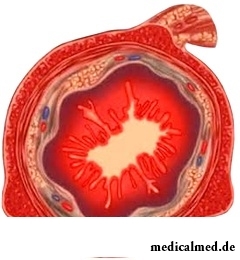





Whipple's disease
Whipple's disease or intestinal lipodystrophy – the general disease of the infectious nature which is characterized by damage of a small intestine with typical infiltration of a mucous membrane of intestines "foamy macrophages", gram-positive batsillopodobny little bodies. Also accumulation in it of lipids, expansion of absorbent vessels, development of a sprue is observed. Whipple's disease develops preferential at men (30:1) age categories of 30 - 50 years. According to various researches about 30 cases in the world annually are registered. 
Etiology of a disease of Whipple
For the first time Whipple's disease was described in 1907 by the pathologist J. Whipple who when opening found increase in mezenteralny lymph nodes with a polyserositis. The bacterial nature of a disease was confirmed only in 1992. By means of polymerase chain reaction Tropheryna whipelii – gram-positive actinomycetes were identified. Actinomycetes are found in an active stage of a disease in mucous membranes of a small intestine. The main reason for development of a disease supposes disturbance of functioning of immune system of various origin now. Localization of bacteria in microphages is characteristic of an active stage of a disease that indicates abilities to a lysis of microorganisms their loss. At a course of a disease of Whipple reduced development of antibodies to the activator in an organism or its total absence is observed. More expressed there is a lack of a cellular immune response.
In spite of the fact that the infestant was identified, the reasons of a course of a disease of Whipple still remain not clear. Scientists do not exclude genetic predisposition. Considerable contamination by the activator of sewage and soils does not lead to mass infection. So far no uniform case of transfer of a disease of Whipple from the person to the person is registered. Researchers believe that not all strains of the activator can develop Whipple's disease and pathological changes, characteristic of it.
Response of an organism to implementation of a disease-producing factor of Whipple are pathological changes in bodies and their systems. So, at Whipple's disease first of all there is a damage of a small intestine. In view of dissimination of the Tropheryna whipelii activator at most of patients defeat of a musculoskeletal system, the central nervous system, cardiovascular system, bronchopulmonary system is observed.
Special value in a course of a disease of Whipple has damage of a small intestine and local lymphatic system. Mucous membrane of intestines of an infiltrovan microphages. Expansion of absorbent vessels, accumulation of fat in intercellular space of a mucous membrane of a small intestine is observed.
Structural disturbances of intestines lead to malabsorption development that complicates transport of nutrients.
Disease stages. Symptoms of a disease of Whipple
During Whipple's disease distinguish three stages:
- The first stage which is characterized by manifestation of abenteric symptoms. At this stage of a disease of the main symptoms polyarthritis, fever of not clear origin, muscle pain, cough with expectoration are. The first stage of a disease can last from 3 to 8 years;
- The second stage of a disease is characterized by manifestation of gastrointestinal symptoms. The main symptoms of a disease of Whipple of the second stage are chronic diarrhea with a plentiful chair to 10 times a day, abdominal pain, painful feelings at a palpation (detection of the increased lymph nodes is possible), a loss of appetite, decrease in body weight, an atrophy of muscles and their weakness. The most serious changes at Whipple's disease are disturbances of fatty and carbohydrate exchanges, a polyhypovitaminosis, a hypocalcemia, development of a heavy sprue;
- The third stage of a disease of Whipple is characterized by development of extra gastrointestinal symptoms, system manifestations. The dysfunction of adrenal glands (lowered by the ABP, nausea, vomiting, anorexia, a xanthopathy), signs of defeat of TsNS (disorder of hearing and sight, defeat of cranial nerves), defeat of cardiovascular system (endocarditises, perikardita, myocardites), skin changes are characteristic of the third stage of a disease.
Diagnosis of a disease of Whipple
 A variety of clinical changes in the struck organism complicates diagnosis of a disease of Whipple. The main diagnostic method is the analysis of a bioptat (the excised wall of a mucous membrane of upper parts of intestines), observation of morphological changes of intestines at endoscopy. The most exact is the method of PTsR-diagnosis (polymerase chain reaction) allowing to define a disease-producing factor of Whipple both in a bioptata, and in other biological environments.
A variety of clinical changes in the struck organism complicates diagnosis of a disease of Whipple. The main diagnostic method is the analysis of a bioptat (the excised wall of a mucous membrane of upper parts of intestines), observation of morphological changes of intestines at endoscopy. The most exact is the method of PTsR-diagnosis (polymerase chain reaction) allowing to define a disease-producing factor of Whipple both in a bioptata, and in other biological environments.
Treatment of a disease of Whipple
Long time was necessary that the lethal outcome is characteristic of Whipple's disease. Use of intensive antibacterial care does the forecast more favorable. At the heart of treatment of a disease of Whipple various antibiotics are applied. The most effective among them are drugs of a tetracycline row. The dosage and terms of therapy are defined on the basis of histologic researches in each case individually.
At severe forms of a disease quite often patients need an additional symptomatic treatment.
For elimination of symptoms of malabsorption to the patient the special diet enriched with animal protein with the limited content of fats is appointed (to 30 g a day). For elimination of symptoms of diarrhea and abdominal discomfort to patients the spazmolitka who are slowing down an intestinal peristaltics are appointed.
Efficiency of the applied therapy is estimated by carrying out a repeated histologic research of a bioptat. Decrease in quantity of macrophages in the studied sample or their total absence is the main sign of efficiency of treatment. Symptoms of a disease of Whipple can be shown slightly longer owing to scale of defeat of bodies.
In our intestines are born, millions of bacteria live and die. They can be seen only at strong increase, but if they gathered, then would be located in a usual coffee cup.

Each person knows that fervescence is an illness sign. However about existence of diseases can to suite...
Section: Articles about health
In consciousness of our many compatriots idea that folk remedies if are no more effective, than medicinal "chemistry" strongly took roots, then are precisely less harmful. Unfortunately, it is not always fair: some receptions treating...
Section: Articles about health
Deciding to get rid of an addiction, not all imagine what effects it is necessary to face. Process of refusal of smoking causes quite essential discomfort in most of people: differences of mood, a sleep disorder, fatigue, decrease in physical and intellectual activity and a number of other symptoms reducing quality of life. Abstinence can be strong: an essential part of attempts comes to an end leaving off smoking failure, and people are returned to the use of cigars...
Section: Articles about health
About 10-15 years ago existence of the computer in the apartment of the Russian was considered as a rarity and office rooms were only on перв...
Section: Articles about health
Small appetite at the child – the complaint which pediatricians should hear practically from each mother. Most often it is carried to the category of children's whims, however the refusal of food in certain cases can be to alarming symptoms therefore it cannot be ignored....
Section: Articles about health
Cold, puffiness of a nose, itch, the watering eyes - characteristic symptoms of the allergic rhinitis resulting from hit of allergens (pollen, house dust, hair of animals, etc.) on a mucous membrane of a nose. Unpleasant feelings often give trouble, serving as the reason of a headache, an acrimony, sleep disorders, and in certain cases and the states close to a depression. How to get rid of undesirable satellites of a disease if near at hand there are no antiallergic...
Section: Articles about health
Smack in a mouth can arise in the natural way – as a result of lack of morning hygiene or reception of the corresponding food. Odn...
Section: Articles about health
Climax - process of fading of reproductive function of an organism in process of its aging. At women the main sign of its approach is the termination of a menstrual cycle. Officially the menopause is diagnosed when periods are not observed in течен...
Section: Articles about health
All know that self-treatment is dangerous. However absolutely it is almost impossible to do without it. Rate of modern life does not allow to handle each small trouble to the doctor and information on ways of independent delivery of health care is quite available. Means, all of us have only one: to learn to give this help competently and in those limits in which it is possible for the person who does not have vocational education....
Section: Articles about health
The hysteromyoma is diagnosed more than at a third of women 35 years are more senior. This high-quality new growth, which on early a stage...
Section: Articles about health
The mankind knows that some toxins at intake in the minimum quantities have therapeutic effect from an extreme antiquity. Many substances recognized poisonous are applied in the medical purposes also today, being the main deystvuyushch...
Section: Articles about health
The body of the person almost for 60% consists of water. It is so important for normal functioning of an organism that loss of only one and a half percent of liquid already leads to the most unpleasant effects. The problems connected with deficit of water can overtake also the healthiest person if he, for example, spends several hours under the scorching sun, without having taken with themselves drink, but is very simple to correct health in this case. It is much more difficult to minimize effects of other reasons about...
Section: Articles about health
Mushrooms - the surprising inhabitants of our planet having a set of wonderful qualities. Thanks to one of them, a mold mushroom of Penici...
Section: Articles about health
The next flu epidemic leads to the next panic, from year to year we give in on these manipulations: professionally alarming voice of the announcer in news, reports with calculation of the died patients, an interview with people in white dressing gowns and advertizing of anti-influenza means ра...
Section: Articles about health
Diseases of joints often begin imperceptibly for the person. The first stages of destruction of the cartilaginous tissue providing soft and free sliding of heads of bones in joint bags proceed slowly and absolutely without serious consequences. Especially unpleasantly for the fact that this process is not connected with advanced age: degradation of joint surfaces is, as a rule, noticeable after 30 years. It means that practically each able-bodied person at any time can face sad results...
Section: Articles about health
Cold is such painful that each sigh becomes a victory, heat "knocks" down, and the ache in joints forces to think only about...
Section: Articles about health
More than a half of the married couples which faced prostatitis – leave. The new broadcast "Female View of Prostatitis" will help to learn – whether you have or your relatives problems....
Section: Articles about health
The dietology, as well as other sciences, does not stand still. Food stuffs are exposed to comprehensive study, and scientists obtain new information on their properties and influence on a human body. Unfortunately, this reasonable and natural process gives unpleasant side effect from time to time: some types of food periodically declare "harmful" or even "deadly" without the bases, sufficient on that....
Section: Articles about health
Life of the modern child is extremely active and difficult. Information strain which is experienced by the school student and did not dream the pupil...
Section: Articles about health
The nature does not stand stagnation and monotony. It is known that tissues of a human body atrophy if do not receive necessary loadings. It fully belongs also to a cerebral cortex: when it is not given full-time job, it begins to function worse. In резуль...
Section: Articles about health
For the help to doctors in the choice of optimal solutions for treatment of various diseases the Cochrane scientific organization (Cochrane) conducts joint researches with representatives of scientific community around the world. The analysis of a series of the conducted researches of the drug Oscillococcinum® relating to group of cold remedies became one of the last methanolyses....
Section: Articles about health
Ayurveda - the most ancient tselitelsky practice which came to us from India. It represents the doctrine about maintenance physical, ps...
Section: Articles about health
Many parents of children at the age of 2-4 years face excessively whimsical behavior of the child. The kid exhausts constant crying and whims not only the parents, but also himself. In what the reasons of children's whims. And how to fight with them?...
Section: Slideshow
According to World Health Organization, every third inhabitant of Earth has excess weight, and every tenth has obesity. The reason of this phenomenon, according to specialists, roots in one not very comforting fact: most of people consume much more calories, than it is necessary. How it turns out what we overeat? Why it is so difficult to refuse an excess portion tasty or additives? Let's try to find out what factors prevent us to eat food with reasonable moderation....
Section: Articles about health
The unpleasant feelings connected with spring breakdown are familiar almost to each of us. Often happens that in March-April on the person...
Section: Articles about health
Some people consider what for medicine of the 21st century of secrets in the field of health of the person almost does not exist. It absolutely not so. The more answers scientists receive, the more the most difficult questions are raised for them by life. Besides, there are diseases, not объясн in any way...
Section: Articles about health
Ability of an organism to resist to adverse environmental factors (to impact of temperature drops, humidity and pressure, to the attacks of causative organisms, etc.) directly depends on what the person eats. Business here not only in that cells of a body received a necessary set of nutrients, vitamins and microelements. Scientists established that such components which are capable to influence negatively immune system, in connection with also are a part of foodstuff...
Section: Articles about health
